Plum trees, like any other plant, have specific nutrients that must be met for optimal growth and fruit production. Understanding these needs is crucial for providing the right fertilization regimen. Fertilizer requirements for Plum trees vary depending on several factors, including soil quality, tree age, and overall health.
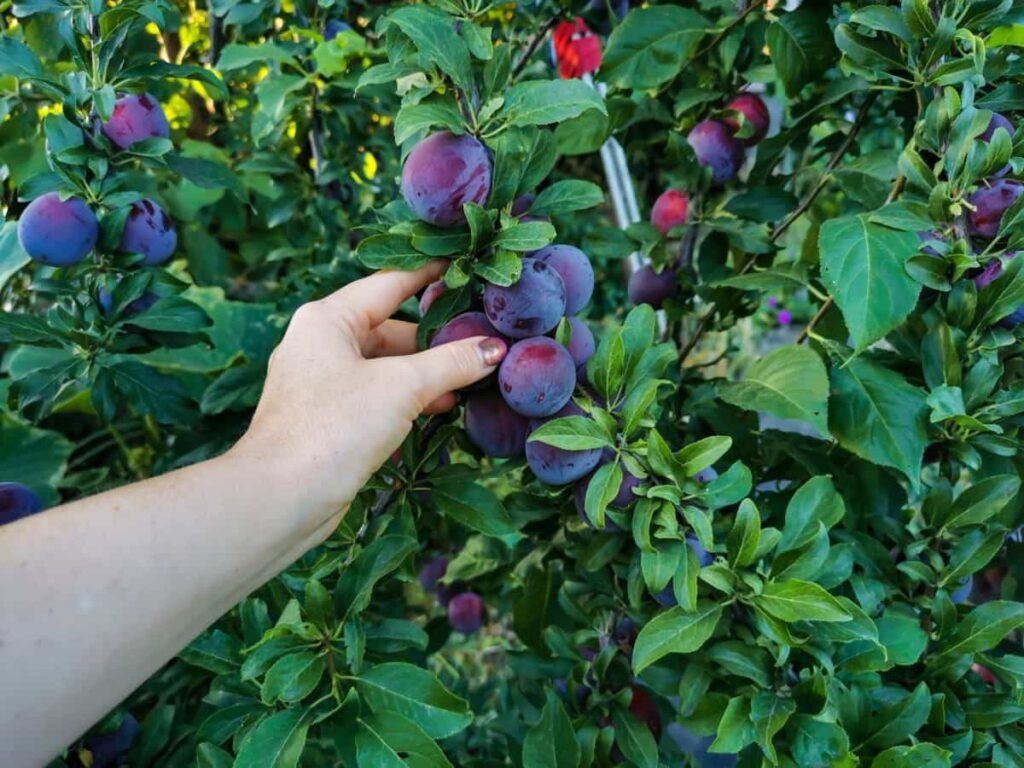
These fruit-bearing beauties require a balanced nutrient intake to thrive and harvest bountiful. Plum trees generally benefit from fertilizers that provide essential macronutrients such as NPK. Fertilizers help improve soil fertility by replenishing nutrient levels that may be depleted over time. Plum trees require well-balanced soil to absorb nutrients efficiently and maintain optimum health.
Fertilizing regularly ensures that the soil remains rich in essential elements needed for robust tree growth. Moreover, fertilizers contribute to overall tree resilience against diseases and pests. Well-nourished Plum trees are better equipped to fight off common ailments and insect infestations as they have stronger immune systems.
Best Fertilizer for Plum Trees
Organic Fertilizers for Plum Trees
- Compost: Rich in essential nutrients and beneficial microorganisms, compost is an excellent organic fertilizer for Plum trees. It improves soil structure, retains moisture, and slowly releases nutrients.
- Manure: Well-rotted animal manure, such as cow or chicken manure, is another effective option. It is high in nitrogen and other essential elements that promote healthy growth.
- Fish Emulsion: Made from fish waste, this liquid fertilizer provides a quick nitrogen boost to fuel vigorous Plum tree growth during the growing season.
Natural Fertilizers for Plum Trees: Exploring Environmentally Friendly Options
One great choice is bone meal, which is high in phosphorus and is a crucial nutrient for root development and fruit production. It can be applied to the soil around the tree’s base or into a potting mix for container-grown Plum trees. Seaweed extract is another fantastic natural fertilizer for Plum trees that offers a wide range of minerals needed for healthy growth.
This liquid concentrate can be diluted with water, sprayed onto foliage, or applied directly to the soil. If you’re looking for an all-purpose natural fertilizer, consider using chicken manure pellets or worm castings. Both options provide a balanced blend of essential nutrients while improving soil health.
In case you missed it: Plum Fruit Orchard Management: A Comprehensive Month-wise Maintenance Guide
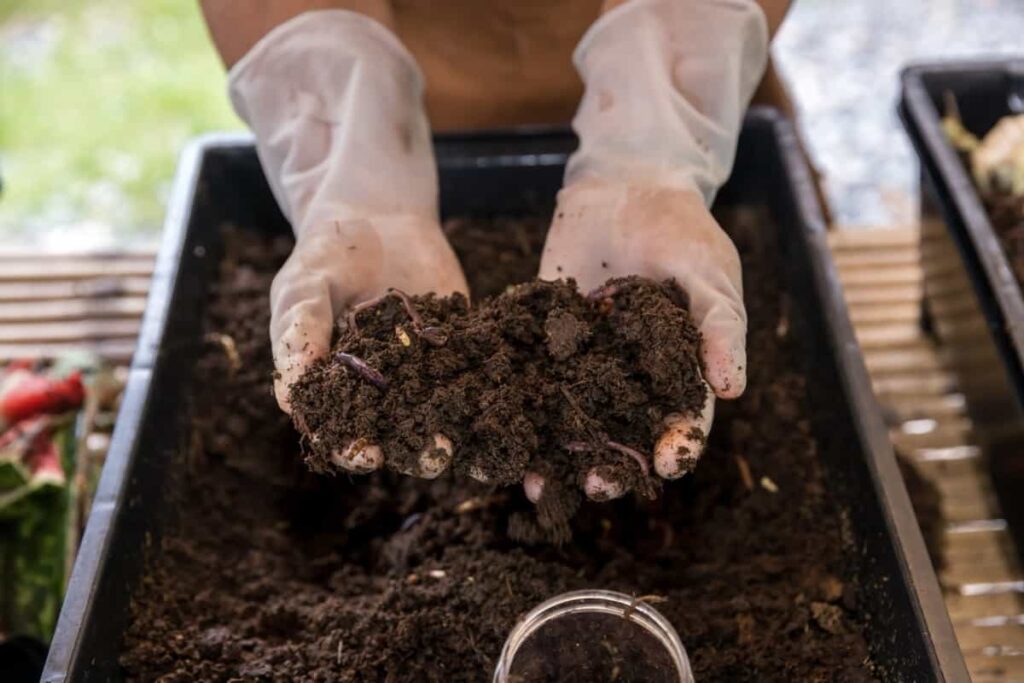
Homemade Fertilizer Recipes for Plum Trees: Cost-effective and Customizable Solutions
One popular homemade fertilizer recipe for Plum trees is compost tea. To make this nutrient-rich concoction, simply steep compost in water for a few days until it becomes dark and fragrant. Then, dilute the mixture with water and apply it around the base of your Plum trees. Another option is banana peel fertilizer. Rich in potassium and other essential minerals, banana peels can be chopped up and buried around the roots of your Plum tree or blended into a liquid form that can be sprayed onto the leaves.
If you have access to seaweed, consider making seaweed extract fertilizer. Soak dried seaweed in water overnight, strain out any solids, and use the resulting liquid as a foliar spray or soil drench. For an extra nitrogen boost, try brewing some nettle tea fertilizer. Nettle leaves contain high levels of this essential nutrient and can be soaked in water for several weeks before being applied to your Plum trees.
NPK Ratio for Plum Trees
Nitrogen is vital in promoting vigorous leaf growth and overall tree health. It aids in developing chlorophyll, which is responsible for photosynthesis, and it is the process by which plants convert sunlight into energy. Phosphorus is essential for strong root development and helps with flower formation. It also contributes to increased fruit size and quality. Plum trees may struggle to produce abundant blooms or set fruits properly without adequate phosphorus levels.
Potassium supports numerous physiological processes within Plum trees. It helps regulate water uptake, enhances disease resistance capabilities, improves winter hardiness, and promotes efficient nutrient utilization throughout the tree’s tissues. A balanced NPK fertilizer of 10-10-10 is often recommended for Plum trees.
The Importance of Nitrogen in Plum Tree Fertilization
Nitrogen is crucial in various physiological processes, including photosynthesis, protein synthesis, and overall plant metabolism. Plum trees require sufficient nitrogen to produce vibrant foliage, promote vigorous root growth, and enhance fruit quality. Plum trees may exhibit stunted growth, yellowing leaves, and reduced fruit production without adequate nitrogen.
In case you missed it: Best Fertilizer for Cantaloupe: Organic, Natural, Homemade, NPK Ratio, and Schedule

Nitrogen helps form chlorophyll, which captures sunlight energy needed for photosynthesis. This process converts carbon dioxide into sugars that fuel the tree’s growth and development. Therefore, ensuring a proper nitrogen balance is vital for optimizing Plum tree health. Providing adequate nitrogen through regular fertilization practices or using organic sources such as compost or manure-based fertilizers rich in this nutrient element ensures optimal nutrition for your Plum trees.
Phosphorus and its Role in Fertilizing Plum Trees
Phosphorus is a vital nutrient for Plum trees’ healthy growth and development. It is crucial in various physiological processes, making it an essential component of any fertilizer regimen. Firstly, phosphorus is responsible for promoting root development in Plum trees. Strong and well-developed roots are necessary for efficient nutrient uptake and plant health.
Additionally, phosphorus aids in energy transfer within the tree’s cells. Furthermore, phosphorus assists with photosynthesis by playing a critical role in capturing light energy during this process. Adequate phosphorus levels enable Plum trees to convert sunlight into usable chemical energy more efficiently.
Potassium’s Impact on Plum Tree Health
Potassium is one of the essential macronutrients required for proper growth and development. Potassium helps in regulating water movement within the tree. It enhances the plant’s ability to absorb water, reducing the risk of drought stress. Potassium aids in strengthening cell walls, making Plum trees more resistant to diseases and pests.
It promotes sturdy branches and stems that can withstand harsh weather conditions or heavy fruit loads without breaking. Potassium also regulates various enzyme activities within Plum trees. It assists in nutrient uptake by enhancing root development and nutrient transport throughout the plant.
Micronutrients for Plum Trees
Micronutrients play a crucial role in Plum trees’ overall health and development. One important micronutrient for Plum trees is iron. Iron deficiency can lead to chlorosis, where leaves turn yellow due to insufficient chlorophyll production. You can apply chelated iron fertilizers directly to the soil around the tree’s base to combat this issue. Another vital micronutrient is zinc. Zinc deficiencies can result in stunted growth and reduced fruit production. You can address this problem using zinc sulfate or applying it directly to the soil as a foliar spray.
Manganese is another micronutrient that plays a significant role in Plum tree health. Manganese deficiency symptoms include interveinal chlorosis and poor flowering. Applying manganese sulfate through either foliar sprays or soil applications can help alleviate these issues. Copper is an essential micronutrient for Plum trees as it aids enzyme activity and photosynthesis. Copper deficiencies often manifest as dieback or wilting of shoots and leaves. Copper-based fungicides are commonly used to provide adequate copper levels for optimal tree growth.
Slow-Release Fertilizers for Plum Trees
Slow-release fertilizers are a great option for providing long-lasting nutrition to Plum trees. These are designed to slowly release nutrients over an extended period, ensuring your trees receive a steady supply of essential elements. Additionally, slow-release fertilizers promote balanced growth and minimize the risk of fertilizer burn.
In case you missed it: Best Fertilizer for Mango Trees: Organic, Natural, Homemade, NPK Ratio, and Schedule
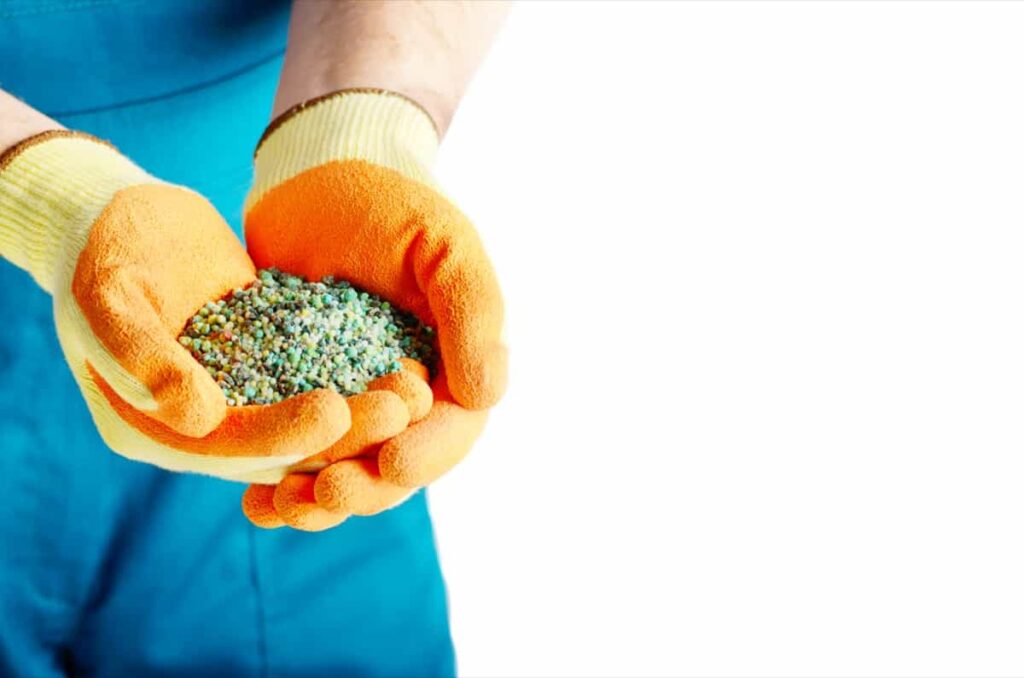
The controlled release ensures that plants receive consistent nutrients without overwhelming them with excessive doses. When choosing a slow-release fertilizer for Plum trees, look for one specifically formulated for fruit-bearing trees or general-purpose options suitable for various plants. Follow the instructions on the packaging regarding application rates and frequency.
Liquid Fertilizers vs. Granular Fertilizers for Plum Trees: Pros and Cons of Different Application Methods
Liquid fertilizers are applied as a spray or through irrigation systems, making them easy to apply evenly across the entire tree’s root zone. The roots quickly absorb them, providing immediate nutrients to the tree. On the other hand, granular fertilizers are solid pellets or powders that are spread around the base of the tree. They release nutrients slowly over time as they break down, providing a steady supply of nourishment to the tree.
Granular fertilizers also tend to have longer-lasting effects compared to liquid counterparts. One advantage of using liquid fertilizer for Plum trees is that it doesn’t require water activation like granular fertilizers. This can benefit areas with limited water availability or during drought conditions. However, one drawback of liquid fertilizers is their shorter lifespan compared to granular ones.
Since plant roots quickly absorb them, their effects may not last as long as granular formulations. Granular fertilizer requires watering after application so the nutrients can be released into the soil and taken up by the roots. This makes it important to consider weather conditions when applying granular fertilizer – heavy rain could wash away some valuable nutrients before they penetrate deep enough into soil layers where Plum trees’ roots grow.
Seasonal Fertilization Schedule for Plum Trees
Properly timed fertilization can help boost growth and fruit production while providing essential nutrients throughout the year. To ensure your Plum trees thrive, following a seasonal fertilization schedule for Plum trees is important. In early spring, apply a balanced fertilizer to Plum trees with an NPK ratio of 10-10-10. During summer, when your Plum trees are in the full leaf and fruiting stage, they require an extra dose of nitrogen (N).
Apply a nitrogen-rich organic fertilizer or compost tea every four to six weeks to support healthy foliage growth and fruit development. As autumn approaches and your Plum trees prepare for dormancy, switch gears toward promoting root growth. Apply a low-nitrogen (N) but high-phosphorus (P) and potassium (K) fertilizer during this time. A 5-10-10 or 4-8-8 ratio will work well. Avoid fertilizing Plum trees in winter when they are dormant, as this may stimulate new growth that could be vulnerable to frost damage.
In case you missed it: Best Fertilizer for Guava Trees: Organic, Natural, Homemade, NPK Ratio, and Schedule
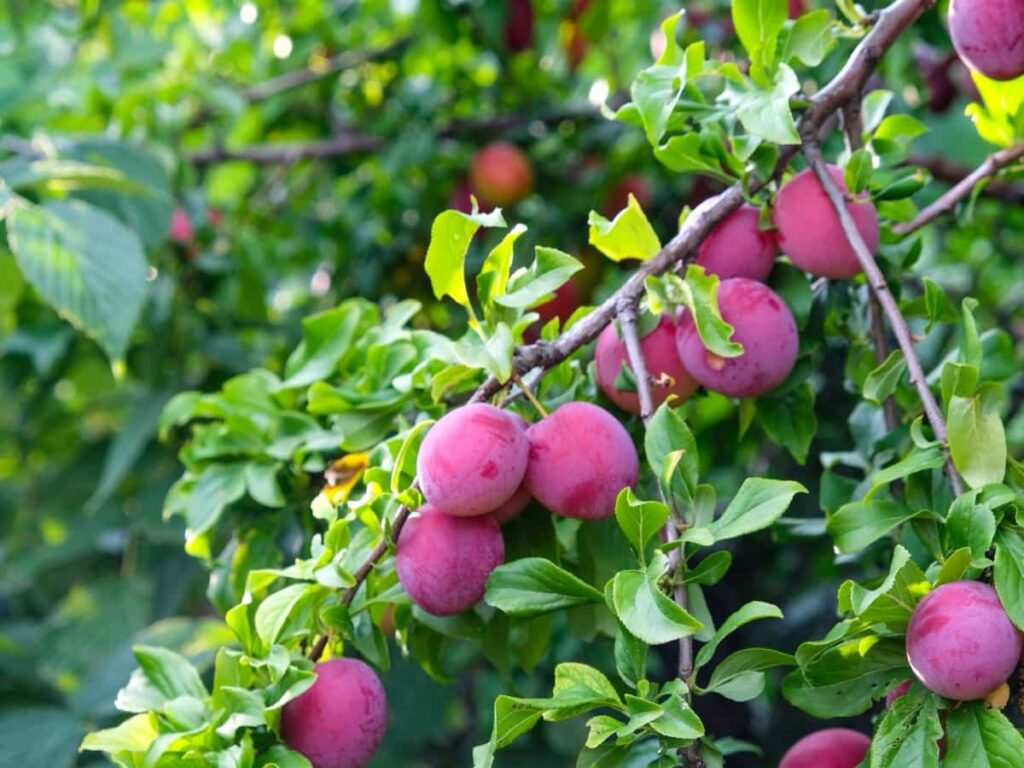
Preparing Plum Trees for Winter with Fall Fertilization
By providing your trees with the right nutrients before the cold weather season hits, you can ensure their health and vitality come springtime. Fall fertilization is crucial because it allows Plum trees to store essential nutrients during the dormant period. This helps them maintain strength and resilience throughout the harsh winter months.
A balanced fertilizer will encourage root growth and nutrient absorption without promoting excessive foliage that could be vulnerable to frost damage. Timing is everything when it comes to fall fertilization. Applying fertilizer around six weeks before your area’s first expected frost date is best. This gives enough time for the tree roots to absorb and utilize the nutrients effectively before they go into dormancy.
When choosing a fertilizer for fall application on Plum trees, look for one with a higher potassium content. Potassium promotes hardiness and disease resistance, vital characteristics during colder months when stressors like freezing temperatures and pathogen attacks are more prevalent. Remember that every tree has unique needs based on its specific soil conditions, age, size, and overall health status.
Common Mistakes to Avoid when Fertilizing Plum Trees
One common mistake is over-fertilizing. Giving your Plum trees too much fertilizer can negatively affect their growth. It’s best to follow the recommended dosage or consult an expert to determine the right amount for your tree. Another mistake is applying fertilizer at the wrong time. Timing is important when it comes to fertilizing Plum trees. Applying fertilizer to the Plum tree too early or too late in the season can disrupt their natural growth cycle and potentially harm them.
Using the wrong type of fertilizer is also a common error. Plum trees require specific nutrients, so using a generic or inappropriate fertilizer may not provide them with what they need. Make sure to select a fertilizer specifically formulated for fruit-bearing trees like Plums.
Best Practices for Fertilizing Plum Trees in Containers or Pots
Firstly, choose a fertilizer that is specifically formulated for fruit trees. This will ensure your Plum tree receives the nutrients it needs to thrive. When applying fertilizer to container-grown Plum trees, follow the instructions on the packaging carefully. Over-fertilizing Plum trees can lead to nutrient burn and damage to the roots of your tree. It’s always better to err on caution and apply less fertilizer than recommended rather than risking harm. To prevent nutrient imbalances, it’s also important to regularly monitor the pH level of your potting soil.
In case you missed it: Best Fertilizer for Red Lady Papaya: Schedule of Organic, Liquid, Natural, Homemade, NPK Fertilizers
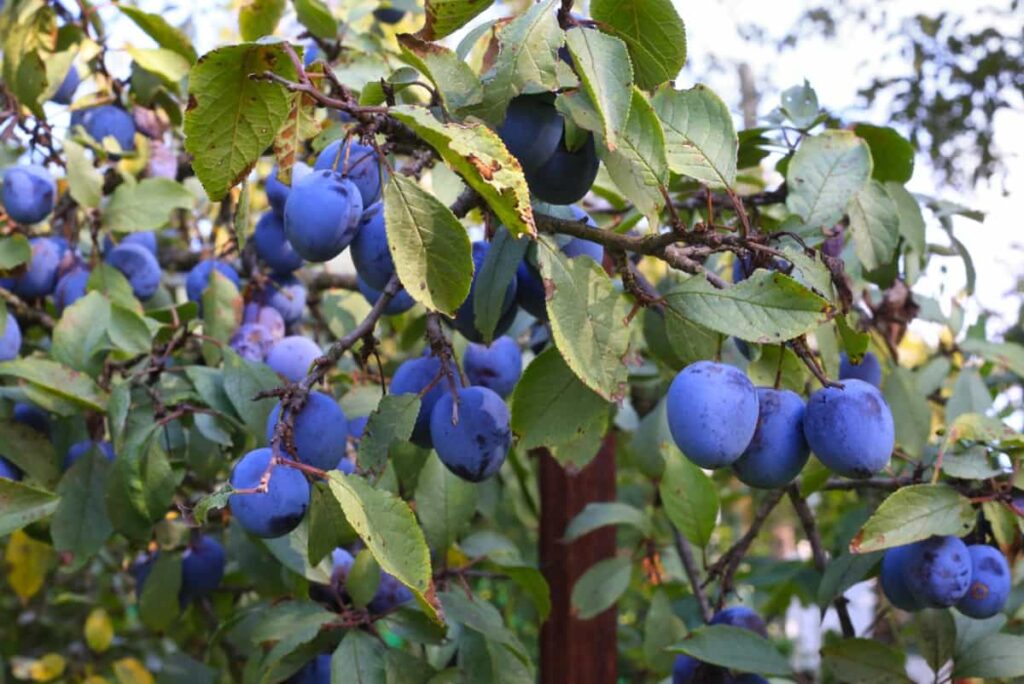
Plum trees need slightly acidic soil with a pH between 6.0 and 6.5. If your soil pH is too high or too low, it can affect nutrient availability for your tree. In addition to regular fertilization, proper watering is crucial for container-grown Plum trees. Ensure that your pot has good drainage and water thoroughly until water begins to flow out from the bottom of the container. Consider supplementing with micronutrients such as iron or zinc if you notice any deficiency in your Plum tree leaves. These essential nutrients are used for healthy growth and development.
Schedule for Fertilizing Plum Trees
| Type of Fertilizer | Fertilizer Details | The Best time to apply |
| Organic fertilizers | Compost, Manure, Fish Emulsion | During the early spring or late fall |
| Natural fertilizers | Bone meal, Seaweed extract, Chicken manure pellets, or Worm castings | Apply during late fall or early winter after leaf drop |
| Homemade fertilizers | Compost tea, Banana peel fertilizer, Seaweed extract fertilizer, Nettle tea fertilizer | During the early spring |
| Slow-release fertilizers | Espoma Tree-Tone Organic Fertilizer, Osmocote | Apply during early spring |
| Micronutrients | Iron, Zinc, Manganese, Copper, Boron | During their active growing season and occurs in late spring or early summer |
| NPK | Nitrogen, Phosphorous, Potassium (10-10-10) | During the early spring, when new growth starts to emerge |
Conclusion
Fertilizer is of utmost importance when it comes to the health and vitality of Plum trees. These fruit-bearing beauties require a well-balanced diet of nutrients to thrive and produce bountiful harvests. Plum trees may suffer from nutrient deficiencies, weak growth, and reduced fruit production without proper fertilization. The right fertilizer provides essential elements such as nitrogen, phosphorus, potassium, and micronutrients crucial for the overall development of Plum trees.
- Profitable Village Farming Business Ideas in 2024
- High-Yield Aquaculture: Fast-Growing Fish for Farming
- Effective Fish Pond Construction Techniques for Beginners
- Irrigation and Water Management in Pineapple Farming
- Blossom to Harvest: Mastering Flowering and Pollination in Papaya Farming
- Pig Fattening Essentials: From Selection to Sale for Beginners
- Raising Wagyu Cattle: A Complete Guide for Premium Beef Production
- Soil Types and Their Water Holding Capacity
- Optimizing Irrigation Schedules for Coconut Groves for Enhanced Yield
- Espresso Your Garden: Coffee Grounds for Healthier Acid-Loving Plants
- The Best Soil Mix for Snake Plants: How to Mix Your Own Snake Plant Soil
- Green Thumb Success: Expert Tips for Cultivating Greenhouse Beans All Year Round
- Bloom All Year Round: The Ultimate Guide to Indoor Hyacinth Care
- Eco-Friendly Gardening: How to Make Liquid Fertilizer from Kitchen Waste
- Ultimate Guide to Grow Anise in Pots: Explore Seed Propagation to Harvesting
- Guide to Raising Chester White Pigs: Discover Breed Facts to Growth Management
- Mastering the Elegance: The Ultimate Guide to Weeping Cherry Tree Care, Planting, and Maintenance
- Ultimate Guide to Planting Garlic in Grow Bags: Growing Strategies for Beginners
- How to Fix Spider Plant Leaf-Related Problems: Natural and Organic Remedies
- 10 Reasons Why Your Tulsi Plant is Shedding Leaves: Home Remedies and Solutions
- Optimizing Growth and Yield: The Advantages of Palm Bunch Ash Fertilizer
- Utilizing Neem Oil Extract as a Natural Pesticide for Hydrangea
- From Soil to Harvest: Various Ways in Which Farmers Can Use AI Tools
- Steps to Encourage and Induce Citrus Flowers: A Comprehensive Guide
- How to Fix Snake Plant Leaf-Related Issues: Natural and Organic Remedies
- Transform Your Garden into a Fragrant Oasis with Raat Ki Rani (Night Blooming Jasmine)
- Discover the Ideal Chicken Breeds for Philippine Farms
- How to Create a Poultry Egg Farm Business Plan for Profits
- Grow Lemon Cucumbers Like a Pro: Insider Techniques for Bountiful Yields
- Ultimate Guide to Caring for Your Pink Princess Philodendron: Tips for Thriving Variegation
- Areca Nut Profit Per Acre: Calculating Yield and Cost of Cultivation
- How Kaveri Chicken is Becoming a More Profitable Breed in Indian Backyards
- Transform Your Barn: 9 Steps to Convert a Horse Stall into a Chicken Coop
- Exploring Suffolk Sheep Disadvantages with Limitations and Challenges
- Guide to Solving Potted Lemon Tree Problems: How to Revive Lemon Tree in Containers
- Steps to Encourage Female Pumpkin Flowers: Best Strategies for More Flowers and High Yields
